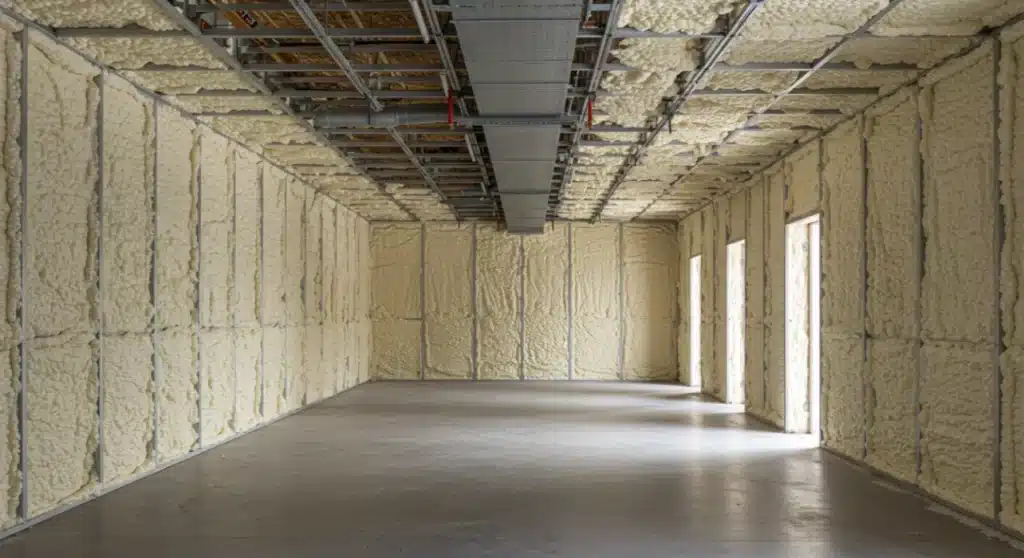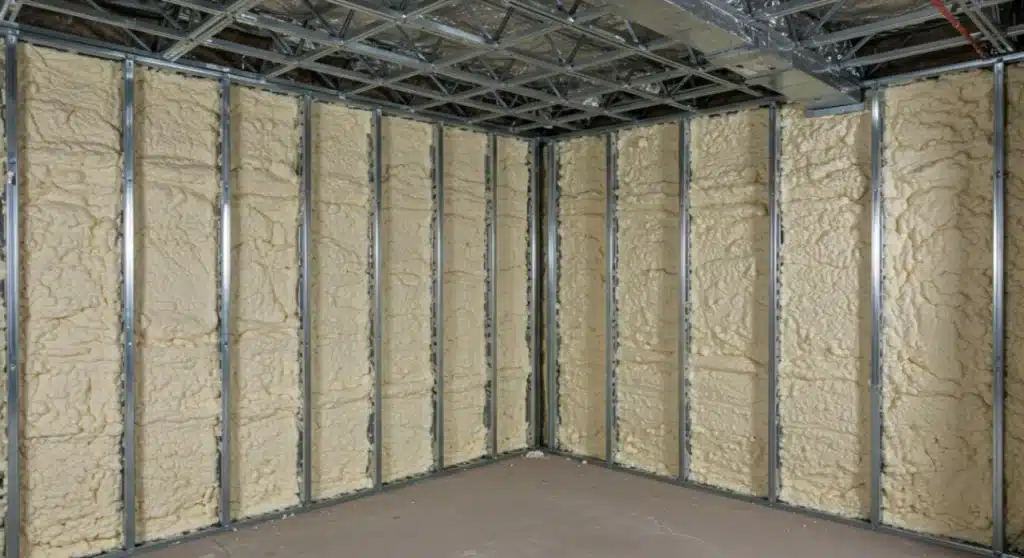Homeowners often face rising energy bills and inconsistent indoor temperatures. Adding new insulation over existing layers can improve efficiency, but it works best under specific conditions. Yes, you can add new insulation over old insulation in many cases, as long as the current setup remains intact and compatible. This approach saves time and cost by avoiding full removal, provided a professional evaluation confirms safety and effectiveness.
This article covers the types of insulation, benefits, risks, and steps involved. Information draws from hands-on projects in Fresno’s varied climate, where hot summers demand reliable barriers against heat gain. Readers gain practical steps to decide if this upgrade fits their home.
Types of Existing Insulation
Attics and walls hold different insulation materials that affect how new layers attach. Batt insulation, made from fiberglass or mineral wool, fills spaces between joists. Blown-in cellulose or fiberglass fills gaps in attics. Spray foam creates a seamless barrier once cured.
Understanding these types is crucial for determining how to add new insulation effectively.
Each type influences addition methods. For example, loose-fill materials settle over time, creating voids that new insulation can fill. Rigid foam boards in walls require careful layering to prevent compression.
In Fresno, where temperatures swing from 100°F summers to 40°F winters, matching new materials to old ones prevents moisture buildup in the dry air.
Bonus Tip: Check for vermiculite in older homes; it may contain asbestos, so test before adding anything.
Benefits of Layering Insulation
Layering boosts thermal resistance, measured in R-value. The U.S. Department of Energy reports that attics with added insulation can cut cooling costs by up to 20% in hot climates like Central California. New layers trap air better, reducing heat transfer through roofs and walls.
A study from the National Institute of Standards and Technology (NIST) shows combined systems reach higher R-values without structural changes. This setup also quiets outside noise, a plus near Fresno’s busy roads.
Homeowners notice even room temperatures year-round. In one local project, adding blown-in over old batts raised the attic R-value from 19 to 38, aligning with California’s energy codes.
Risks When Adding Over Old Insulation
However, while layering offers clear advantages, there are important risks to consider.
Not all additions go smoothly. Compressed old layers lose effectiveness, and mismatched materials trap moisture, leading to mold in humid spots. The Building Science Corporation warns that fiberglass over spray foam can create condensation if vapor barriers clash.
Dust and allergens from disturbed old insulation pose health risks during work. In Fresno’s dusty environment, airborne particles worsen indoor air quality temporarily.
Structural weight adds up; too much blown-in material overloads ceilings. Always calculate loads to avoid sagging.
Assessing Your Current Insulation
Start with a visual inspection. Climb into the attic with a flashlight to spot gaps, discoloration, or damage. Measure depth: aim for at least R-30 in Fresno attics per local building standards.
Use an infrared camera to detect cold spots on walls. Professionals drill small holes for borescope views in hard-to-reach areas.
Market data from Energy Star indicates 75% of U.S. homes have inadequate insulation, with California homes averaging R-19 in attics, below recommended levels.
The following table summarizes key insulation types, their R-values, layering compatibility, and Fresno-specific issues.
Bonus Tip: Label insulation types on access panels for future reference; this speeds up assessments during routine maintenance.
| Insulation Type | R-Value per Inch | Compatibility for Layering | Common Issues in Fresno Climate |
|---|---|---|---|
| Fiberglass Batt | 2.9-3.8 | Good with blown-in or foam | Settles in heat, needs support |
| Cellulose Blown-in | 3.2-3.8 | Excellent over batts | Absorbs moisture if not treated |
| Spray Foam (Closed-Cell) | 6.0-7.0 | Limited; expands to fill | High cost, but seals air leaks |
| Rigid Foam Board | 3.8-5.0 | Fair in walls | Gaps form if not taped properly |
This table compares options based on performance and layering feasibility.
Things to Consider Before Making a Decision
Evaluate your home’s age and construction. Older Fresno ranch styles with vented attics suit blown-in additions, while modern sealed homes need vapor-permeable materials.
Budget plays a role; adding over costs 30-50% less than removal, per Oak Ridge National Laboratory estimates. Check for rebates through California’s energy programs.
Local codes require permits for major changes. Hire certified inspectors to confirm fire safety, as some foams need ignition barriers.
Climate factors matter: Fresno’s low humidity reduces rot risks, but intense sun demands UV-resistant exterior coverings.
Consider long-term goals. If selling soon, focus on quick gains; for staying put, prioritize durable options.
Bonus Tip: Document before-and-after energy bills to track savings and justify costs to insurers.

Step-by-Step Process for Adding Insulation
Prepare the space by clearing debris and sealing vents. Wear protective gear to handle old materials safely.
Choose compatible new insulation. Blown-in works well over most types; apply evenly with a machine for uniform coverage.
For walls, remove baseboards and drill holes to blow in material, then patch and repaint.
Test air sealing post-installation with a blower door. In Fresno projects, this step catches 15-20% more leaks missed visually.
Monitor for a season to ensure no issues arise.
Common Questions
How much does adding insulation increase home value?
Real estate data shows 5-10% boosts in energy-efficient homes, especially in sunny regions like Fresno.
Does layering void warranties?
Most manufacturers allow it if installed correctly, but confirm with product specs.
Can you add insulation in winter?
Yes, but dry conditions in Fresno make year-round work feasible without frost delays.
What if pests live in old insulation?
Treat infestations first; untreated areas attract more rodents.
Key Points to Remember
Adding new insulation over existing works when assessed properly, offering better comfort and lower bills. Weigh compatibility, climate, and costs to choose the right path. Evaluate your home’s setup, consult codes, and aim for balanced efficiency. Tailor choices to specific needs and future plans for lasting results.
Next Steps for Your Home Insulation
Assess current conditions to see if layering fits. For guidance in Fresno, contact Supreme Spray Foam – Fresno at (559) 545-0800 or [email protected]. Schedule an inspection to get tailored advice on materials and processes that match local climate demands. This step ensures safe, effective improvements without guesswork.
Sources
- U.S. Department of Energy – Government resource on insulation benefits and energy savings in various climates.
- National Institute of Standards and Technology (NIST) – Research on thermal performance of combined insulation systems.
- Building Science Corporation – Expert guides on risks like moisture in layered insulation.
- Energy Star – Program data on U.S. home insulation adequacy and market statistics.
- Oak Ridge National Laboratory – Studies on insulation costs, energy efficiency, and regional applications.
Questions Homeowners Often Ask About Insulation Upgrades
How Do You Know If Your Existing Insulation Needs Help?
Signs include high utility bills, uneven heating, or ice dams in winter. Inspect for thin spots or discoloration, which signal degradation.
Is Spray Foam Safe Over Fiberglass?
Closed-cell spray foam seals well over fiberglass, but open-cell risks moisture. Use closed-cell in Fresno’s dry climate for best results.
How Long Does Layered Insulation Last?
Properly installed layers endure 20-50 years, depending on material. Regular checks extend life by catching early wear.
Can DIY Handle This Upgrade?
Small attic jobs work for handy types, but walls and foam need pros for even coverage and safety.
What Energy Savings Expect in California?
Adding R-10 over existing cuts bills 10-15%, per state audits, with greater impacts during peak summer use.


